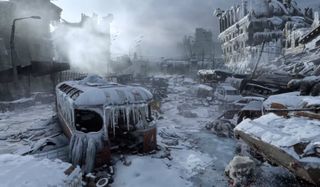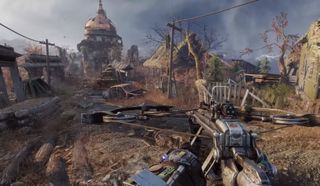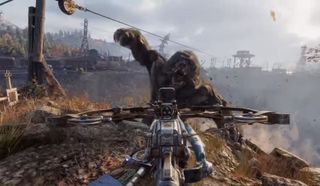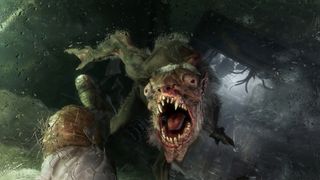Metro Exodus takes the series above-ground for a year-long journey through post-apocalypse Russia
4A Games talks weapon customisation, enemy AI and taking the series to the overworld.

Since its reveal at Microsoft's E3 conference last weekend, we've learned quite a lot about 4A Games' latest slice of Metro. Following in the footsteps of its forerunners, Exodus is another first-person shooting survival horror game set is post-apocalyptic Russia. Unlike its series siblings, though, this one is set above ground, has non-linear levels, and is said to draw from the Stalker series' open world design.
At E3, we caught up with the game's executive producer Jon Bloch and creative director—and 4A Games co-founder—Andriy "Prof" Prokhorov to find out more.

Jon Bloch is the executive producer of Metro Exodus whose resume also includes work on its forerunners 2033 and Last Light. Andriy "Prof" Prokhorov is the game's creative director and co-founded 4A Games in 2005.
PC Gamer: Can you talk us through Metro Exodus' story and where we find ourselves at the start of this game?
Jon Bloch: [Laughs] Straight into it. Yeah, so the game picks up where Metro: Last Light left off with the good ending. Artyom is back and now he needs to join together with a small group of survivors and board a train and escape Moscow. He goes on an epic journey that spans the continent and goes across post-apocalyptic Russia. The whole journey takes about a year and we get to see all the seasons in the year and we get to see that journey and how the time and everything that happens along the way affects the characters and how the characters change.
Players will get to explore the world outside of the Moscow Metro which is pretty much where the last two games have exclusively taken place—underground. We've gone above ground a little bit in previous games but that's going to be a lot of more of that in this next game.
I remember the airplane sequence quite vividly from the second the game—that was one of the most striking images with its colour palette and everything that went with it. It's exciting to see that you're moving into more of that.
Jon: Yeah, specifically from there: the contrast between that vision of that scene versus basically everything we've seen in previous Metro games—it's always been winter, it's cold, snow, you know, that perpetual winter. Now we actually get to take you into different environments and different seasons. You saw Autumn in the trailer, that's a level later in the game.
I think one thing there's a little bit of ambiguity about is whether it's an open world game or not. Can you clear that up for me?
The biggest gaming news, reviews and hardware deals
Keep up to date with the most important stories and the best deals, as picked by the PC Gamer team.
Jon: It's a combination of the classic Metro gameplay that everyone is used to from previous games where it's that linear style of gameplay. The level that we show in the trailer is later in the game and is one of our non-linear levels.
We're doing this mix of classic gameplay and this new non-linear style and we wanted to maintain what our fans expect, what they've known, and what they're used to and love, while also introducing something new that is blending of what we've done over the past two games and plus something that the core team at 4A Games has done in the past with the Stalker games.
We're not entirely open-world, then, it's more sandbox survival and everything is tied together with an overarching storyline that still carries the player through. They're still feel like they're playing a Metro game.

You say sandbox survival—is there anything else that'll reflect the open world, other elements that reflect the change in setting? Do you have survival mechanics or anything like that?
Jon: There are a lot of features that we're not talking about yet in detail but we have revamped certain systems. The weapons system, for example, you'll have a lot more freedom in customisation with your weapons. You saw in the trailer where Artyom crafts a magazine and swapped it out for the revolver mechanism for his shotgun—things like that are where we're giving the player a lot more customisation options.
There's a lot more exploration, there's a lot more open freedom in the sandbox areas to explore, to go in the direction you want, to do the things that you want. There's still story within those levels that will guide you through the places you should go but it supports being able to go where you want and do what you want.
Is the sense of journey more hopeful in tone than we've maybe seen from previous games, or is it still a very bleak journey that Artyom takes?
Jon: Again without going to much into the story, yes there is a sense of: let's go see what's out there and hopefully we'll find something that's new and interesting and a good place to live.
Prof: Yes, for the team that's the plan. It's a much brighter journey because after two games in the tunnels, the team was tired of [the setting]. We can't say much on the scenario—maybe it'll kill us if we tell you something!
Is it much more challenging for your team to build this world, given that you can't just put them underground this time?
Prof: Definitely. From the beginning it was like: yeah, it will be easy. We combined the experience of the two projects, our core team's projects, which started with Stalker: Shadow of Chernobyl, and after that Metro.
Jon: It wasn't as easy as we thought it'd be when we started. Taking those two experiences from the team and putting them together—two years into development and we were still trying to figure out how to make it work. We have it in a place now where we think: works. And it's really cool.
Prof: Having a lot of freedom, immediately killed the scenario as far as narrative gameplay is concerned. It was really difficult.
Jon: Yeah, it's hard to be fully open but story-driven at the same time.

I guess being in those open environments does that, where you can still have these player created moments in terms of how the AI relates to the player and being in that world.
Jon: Yeah, that's one of the goals. When you're walking around one of the non-linear levels, you'll experience them a lot more dynamically than compared to the previous Metro games. But there are still elements that make it feel like a Metro game, it doesn't feel completely different—it's got flavour from something else and there are still combat, survival, exploration elements that we're used to. We've just infused them into these more sandbox-style levels.
Prof: You mentioned AI before. Previously, our AI wouldn't work in conditions of free-roaming player, which is why we've added a biome system [that lets] players pinpoint where specific animals or enemies may be.
Jon: Yeah, it's a lot more dynamic, the world feels more alive.
Speaking to the variety of environments, does that mean that enemy types will vary across the seasons?
Jon: Yeah, mainly because you're travelling to different areas. It's a long journey so when you get to a new place it'll be a new season in that new place. So you get both a new environment plus a new season and you're meeting new people. There might be new wildlife that lives there, there's going to be different societies, different ideologies, all these different experiences each time you step off the train.
Prof: We never use copy and paste development, so we always try to do something new, something to do with each step of the way. Here, it's moving between continents. Each time it's a new society, new landscapes, new monsters. It's a really ambitious project. We've worked really hard on it.
Assuming the AI behave differently, you're in these open environments, the weapons you have to combat this have changed as well—can you talk a bit more about the weapons of the game and the tools you use against what you face?
Jon: There's going to be a wide selection. There will be a lot of familiar weapons from the series, but they will in some cases look newer. This is because the weapons system has been completely overhauled and we've added a lot of customisation options.
There's different ways that you can construct these weapons and while we're not getting too much into how and what those differences are yet—but that whole system has been overhauled. It'll provide the players with a lot more variety as to how they want to encounter a scenario.
Prof: On the previous projects, our weapons worked in a theoretical spectrum. That's been removed here, our weapons are now mechanically sound.
Jon: Yeah, in the trailer, we wanted the explosive arrow to be understandable so that people could see it's an explosive arrow—it should be bigger and red, so that you know it's going to explode.

One of the things I loved about previous Metro games is the smaller stories. You hear of everyone living their lives in metro systems—how does that play out in the open world, do you still have those characters you might have a one-off interaction with, are there still micro stories dotted around?
Jon: Yeah, even in the non-linear levels there are places where you can get that, for sure. We also have other areas where along the train will be places where you can absorb a lot of that city station feel from the previous games with the group that you're travelling with. But there certainly will be other places where you can come across mini stories, or where you'll meet someone individually and you'll get that story from them.
I guess the seasonal approach lets you develop people and how they change over time.
Jon: Yeah, you get to see how they change along with you—the things they go through, the things you go through and how everything affects the group in general.
If I can ask about the more technical side of things—the Metro games have always been way ahead of the curve with it comes to visuals on PC. Can you talk about that side of things?
Jon: It's always been a priority for us to be up there and, as you say, ahead of the curve. Our engine is a proprietary, called 4A Engine which we've been developing since the studio opened in 2005, and we upgrade it for every game. We use it for all of our games as well and it's built from the ground up and is built so that we can take full advantage of every platform that we release on.
The platforms that we support, we target the strengths of each platform and utilize them to the max and so the case of PC is that we try to make sure that if you have a lower end card that's within our specification, it'll still work and will stay play and look great. If you have that high end max, ridiculous video card—we'll blow it up. We'll still push it to its limits. That's always a priority for us.
Prof: Be sure it is. I'm always pushing render programmers: more, more more! In 4K we're using extreme quality.
Most Popular

